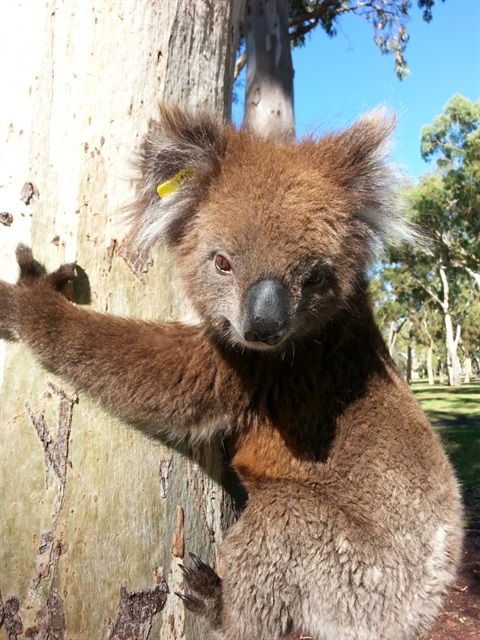Koalas

Koalas are an iconic Australian animal that can be observed in public and private locations in the City of Burnside, including parks and private gardens. They are typically seen in gum trees, but they do use other trees for shelter and are sometimes found walking between trees.
When Europeans settled in Adelaide there were no koalas here. Koalas were introduced into the Mount Lofty Ranges around Adelaide in the 1950s and 60s. There is now a relatively large population of koalas in the region. This population of koalas is important nationally, as koala populations in Queensland and New South Wales are declining.
Interacting with koalas
Koalas are beautiful animals and it can be exciting to see them but do keep your distance. Approaching a koala can stress the animal and koalas can bite and scratch if you get too close.
Threats to koalas
In suburbia, threats to koalas include dog attack, vehicle collision and loss of habitat. Residents can contribute to koala conservation and welfare by:
- Keeping dogs under effective control.
- Maintaining canopy cover (trees) on your property, particularly Eucalyptus (gum) trees.
- Slowing down while driving on roads where koalas might cross (if there is a koala crossing a road, be careful not to swerve into traffic or stop your car where you might cause a vehicle accident).
Sick or injured koalas
If you have a koala in your garden, there is no need to call a wildlife rescue organisation unless it is sick or injured. Koalas will find suitable trees by themselves and moving koalas unnecessarily will cause them stress.
If you find a sick, injured or orphaned koala outside of a National Park Reserve you should contact your local wildlife rescue organisation, or a local veterinarian, as soon as possible. Options include:
If you find an injured koala in a National Park Reserve or wish to report a dog attack on a koala please contact Cleland Conservation Park on 8130 9050 or Belair National Park 8278 5477 (business hours).
Water for koalas?
While koalas will drink supplementary water, they do obtain the water they need from the leaves they eat. During heatwaves in some country areas, leaf moisture is reduced and supplementary water is beneficial for koalas. In the City of Burnside, urban park watering is increased during the warmer months and heatwaves. Therefore supplementary water for koalas is not necessary in our parks because the trees are well watered.
If you would like to provide supplementary water for koalas and other wildlife on your property, please consider the following guidelines:
- Use the right device: a flat tray or container on the ground can work for koalas, a raised birdbath is better for birds, and a shallow bowl would be good for a bluetongue lizard. If you are using a plastic container, place a rock in it to avoid the empty container blowing away.
- Location, location, location: water for wildlife should be inaccessible to pets to avoid contamination and interactions that can lead to disease or injury. Also, make sure the water is shaded so it does not evaporate or become excessively hot.
- Keep it clean: unclean water can spread disease – watering stations must be cleaned daily to reduce disease risks and potential for mosquito breeding.
- Safety first: small birds and animals can drown in water bowls. To avoid drownings, place a stick in the container as an escape ladder. And never place a water bowl that could create a drowning hazard for babies and children. It’s also important to wash your hands after cleaning a wildlife watering station.
- Only when it’s hot and dry: permanent drinking stations can attract predators, like cats and foxes, so only provide water when it’s really needed (eg over 35 degrees).
Further information about koalas
Further information is available online from the Department for Environment and Water.